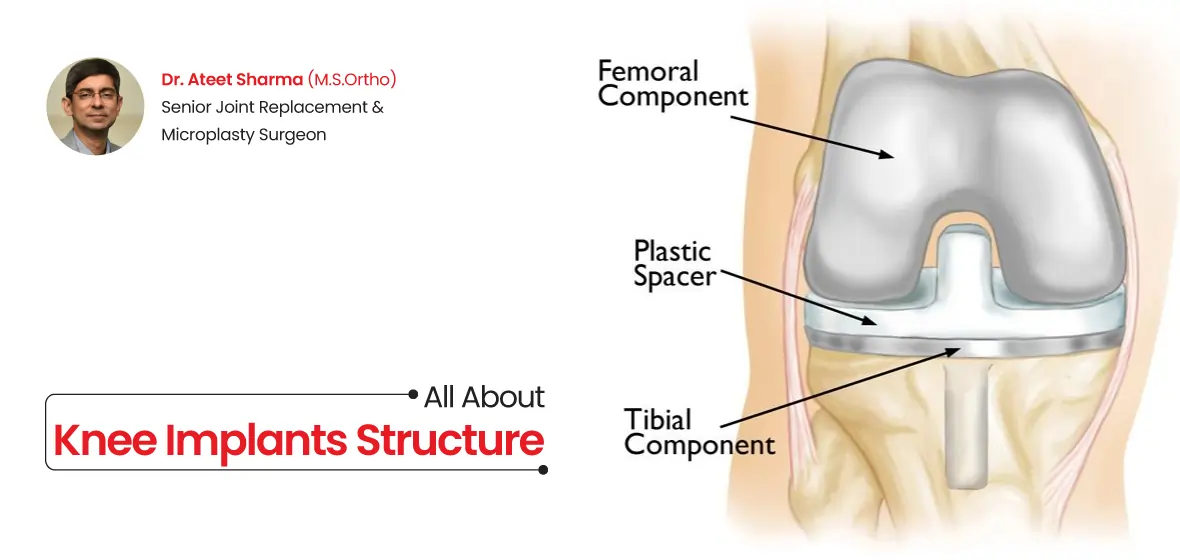
The knee is an essential part of the body that allows an individual to walk, run, bend, and enjoy every aspect of life. Over time, this required part may start breaking down due to injury, arthritis, or casual wear and tear and limit your movement to a point. Here, our Knee Replacement Treatment in Ahmedabad guides you about a procedure designed to give your knee a fresh start.
During the surgery, an orthopedic surgeon replaces the damaged parts of your knee with specialized artificial components called implants. It is not just a new knee but a new lease on life!
The knee implants consist of metal, plastic, or ceramic, designed to replace the natural functioning of the knee movement. The worn-out area is removed, and new components are placed precisely to maintain the smooth and steady functioning of the knee.

When it comes to the selection of knee implants, there is no such component that can fit every individual. However, each knee implant is chosen based on multiple factors affecting the patient. The factors that affect the decision are the age, weight, activity level, and the specific condition of the knee. All of these factors play a key role in determining the best-fit implant.
The right tool makes the job efficient, and with the right implant, you can look forward to smoother, more comfortable movements.
Now, let us dive into Knee Implant Structure.
Knee implants help damaged parts of the knee joint function smoothly. Three areas of the knee can be replaced with these implants. A simple breakdown of these is stated below:
The first part that gets an implant is the lower end of the femur, the thighbone. The implant is made of metal and shaped like a cap to create curves around the bottom of your thighbone.
It helps to bend the knee and let it function smoothly.
The next implant is the top surface of your tibia, which gets a flat metal piece called a tibial component. The metal part here is just like a platform, and on its top, a cushion made of plastic is fixed. It helps in smooth functioning over time.
In a few situations, there is no cushion made of tough plastic.
Lastly, the back of your kneecap may also need an implant, as it is usually a dome-shaped plastic piece that fits the shape of your kneecap and helps it glide smoothly as the knee moves.
The kneecap may not require any implant if it is in good shape.
It is a fact that these implants work together smoothly to ensure the better functioning of the body. The metal parts meet with plastic and not metal-to-metal. It helps reduce friction and wear over time.
The discussed design ensures that the knee can move without causing damage to the implant. It provides comfort and long-lasting results.
Knee implants are framed using high-quality materials. Thus, it can last for many years. Some of the primary materials used are :
Metal Parts :
Plastic Parts :
Ceramic Parts :
The material used for the Best Knee Replacement Treatment in Ahmedabad by our experts is biocompatible, ensuring it is safe for your body and would not be rejected. It is also strong enough to handle the weight and pressure the knee experiences daily.
Once the knee implant is ready, the next step is that it is attached to bones. There are three main methods in this process :
Cemented Fixation : Cemented Fixation is one of the most common methods and is preferred in most cases. Bone cement is used to attach implants to bones. This cement has a specialty for drying quickly and creating a stiff bond
Cementless Fixation : In the method of Cementless Fixation, the implant is not glued to the bone. However, the implant is pressed tightly against the bone, and over time, the bone naturally grows into the surface of the implant.
The implant includes materials that encourage new bone growth.
Hybrid Fixation : The hybrid Fixation method combines both of the above methods. Here, a part of the implant is attached with cement, while another part is left for the bone to grow.
The design of knee implants varies depending on the prevailing situation.
Posterior-Stabilized Implants : In this design, PCL (posterior cruciate ligament) is removed, and the implant is placed to take over the job of this ligament. It prevents the thighbone from sliding forward.
Cruciate-Retaining Implants : In this method, the PCL is kept in place, and the implant works alongside it. Cruciate-retaining implants are used to support the knee when PCL is strong and healthy.
Fixed-Bearing Implants : Here, the plastic part of the implant stays fixed. However, the metal part of the implant moves on top of the plastic and acts like a cushion. It is the simplest and most common design.
Mobile-Bearing Implants : In this implant, the plastic part can rotate slightly and provide access to movement range. It ensures more flexibility.
There are various designs of knee implants depending on how much of the knee is replaced and whether the surgeon keeps your natural ligaments. Dr. Ateet Sharma is one of the best Orthopedic surgeons in Ahmedabad to provide you with the right guidance when it comes to any query or issue related to your knee. Consulting the expert will not do any harm.
© 2025 Dr.Ateet Sharma All rights reserved. | Manage by Nexus